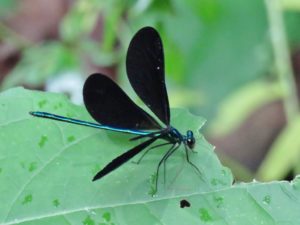
The progression of the summer season is very much evident now. Although birds are still singing with as much enthusiasm as a month ago, many are already tending to young that have left the nest, or are raising a second brood. At the feeders, young cardinals and house finches beg for food from their parents while young robins dot the landscape of lawns and shrubs. Early blooming shrubs are already setting fruit, just in time for birds to help them distribute their seeds to new places. At our headquarters, many birds are eyeing-up the big mulberry tree, the most effective bird feeder we have. The young ospreys are growing by leaps and bounds, keeping their father busy catching and hauling fish to the nest. Two of the three eggs they tended hatched, which is fine for the pair of young. They will receive plenty of attention and fishy meals.
Coreopsis and spiderwort and mints are blooming in the meadows, along with milkweed. Along with the wildflowers, insects are starting to come into their own now. Among those milkweeds we are seeing many monarch butterflies, and finding many eggs and caterpillars. I wish they had more protected places like ours. Other butterflies are evident now- blues and skippers, swallowtails and sulphurs, all adding their color to the summer landscape. Even more numerous are the moths and beetles of all sorts shiney like tiny jewels. Except for the rose chafers and Japanese beetles perhaps, as they are alien jewels we’d rather not see.
A couple of weeks ago one only saw the large bumblebee queens, but now the smaller workers, looking like miniature versions of their royal mothers, dot the flowers in our gardens – their pollen baskets, or corbicula, on their back legs overflowing with protein-packed granules to be brought back to their nests. One can’t survive on nectar alone, it turns out, and the bees have developed a wonderful way to convey what they need back to their families.
Especially noticeable around water, are the dragonflies. I use the term meaning to include all those in that group – damselflies, clubtails, and all forms of these beautiful and impressive insects. Right now, just a few feet from the beginning of Cattail Trail, there are many different species, including bluets (little blue damselflies of some sort), whitetails, twelve-spotted skimmers, pondhawks, and black, and red saddlebags (which might be a Carolina saddlebag). In the algae growing in the pond are many dragonfly larvae or nymphs, and new species are constantly emerging. In younger days I didn’t pay much attention to dragonflies save the bluets and the common green darner, a migratory species. Over the years, although I am just barely familiar with them, I have become more aware of the many different species that we are blessed with.
The dragonflies are predators, and seem to spend their adult lives mainly eating or reproducing. They will fly right up to you and snatch a mosquito or deerfly buzzing around your head with amazing speed. They locate a mate and attach themselves, reproducing on the fly, often laying eggs on vegetation in the water. Their nymphs hatch and grow, spending most of their lives below surface until emerging next year at just the right time to find a mate of their kind.
There are more and more people becoming interested in the dragonflies- there is a Wisconsin Dragonfly Society whose members help each other with tricky identifications of species, the sorting of which can be amazingly subtle and complex. And although I’m afraid I will never be an expert on dragonflies, their presence, along with the birds and mammals, insects and wildflowers of our Lakeshore, seems to make our world more complete.
photo- an ebony jewelwing damselfly, the author’s favorite species
Jim Knickelbine
Executive Director
Woodland Dunes Nature Center and Preserve
